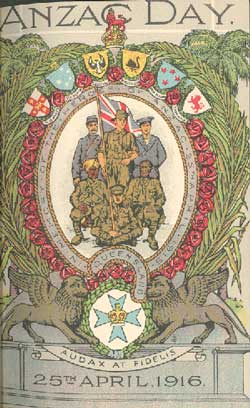Background

The foundations for the commemoration of Anzac Day were established long before the day was first formally observed. Queensland state schools had been celebrating Empire Day and Trafalgar Day based on Australia's historic connections to Britain for some time prior to 1915. The commemoration of Anzac Day in Queensland state schools was grafted onto these existing traditions and special days.
Anzac Day has been remembered in Queensland state schools since 1916, the year following the landing at Gallipoli. School services originated from a directive from the then Minister for Education, Herbert F Hardacre in the
Education Office Gazette of April 1916.
State schools were instructed that they should:
'Commemorate Anzac Day by suitable addresses to their pupils, dwelling upon the gallant landing of our Australian and New Zealand troops on the Gallipoli Peninsula, their splendid achievements, their sacrifices, and their loyal devotion to duty, our grief at the great loss they suffered; and our country's debt of gratitude to them and theirs'.
Background material for Anzac Day speeches could be found in
The School Paper of April 1916. This issue discussed the events leading up to as well as the actual landing at Gallipoli, the meaning of 'VC' and highlighted the heroic deeds done by soldiers in endeavouring to defeat the enemy. Schools with Union Jacks were directed to fly them alongside the Australian flag on that day. Mr Hardacre also proposed that Queensland school children write letters to the children in other parts of the British Empire and allied countries and forward them to the Department of Public Instruction (now Education Queensland) and they would be sent onto their destinations.

Photograph: First Anzac Day service at the
Brisbane Normal School (1916).
The old Normal School (closed in 1926), which once stood on the corner of Adelaide and Edward Streets in Brisbane, was a famous early Brisbane school. At the time of its first Anzac Day ceremony in 1916, a newspaper report revealed that from 500–600 of its former boys had passed into the ranks and now comprised twenty per cent of the metropolitan officers. Mr Hardacre addressed 1,400 Normal School children, teachers and parents, indicating that it was the desire of the Department of Public Instruction to enshrine this day as a very significant event in the history of Australia and ensure that it was fittingly observed annually in schools in both urban and remote areas.
Features of school commemorative services
Anzac Day commemorative services in state schools were generally held each year after 1916. Reminder notices appeared in annual
Education Office Gazettes wherein the Minister for Education nominated a specific date close to 25 April to hold commemorations. It was suggested that material for addresses at these services could be derived from
The School Readers and
The School Papers.
The features and extent of commemorative services in Queensland state schools have varied, depending on the location and size of the school. Anzac Day services have included special assemblies, parades, essay competitions, wreath laying, addresses by senior military personnel and the playing of the 'Last Post'. More modest celebrations may have been held in smaller schools and in country areas, the local school was often the focus of the community.
By the 1950s, many Queensland school children were listening to the broadcast to schools, 'We Honour the Anzacs', through the old grey speakers, the 'grey ghosts' as part of their school commemorations. This broadcast included the singing of the Anzac Day song, an explanation of the 'Last Post' and 'Reveille' and the observation of a brief silence followed by the playing of the latter. The sale and wearing of Anzac Day badges at school also became part of the Anzac Day commemorations from the late 1950s.
Little changed in the observation of Anzac Day in schools in the years that followed. By the 1970s, principals who wanted to arrange speakers for school ceremonies were invited to contact the Anzac Day Commemoration Committee if in Brisbane or the local sub-branch of the Returned Servicemen's League if outside the metropolitan area. Principals were expected to ensure that teachers provided instruction to students on the importance of Anzac Day. The type and depth of instruction could be modified so that all students, regardless of ethnic background, gained an understanding of the significance of Anzac Day in Australian history.
The events of the first Anzac Day continue to be remembered each year in Queensland schools. In many schools, as well as organising and participating in Anzac Day services, children are encouraged to write about the significance of Anzac Day in Australia's history.
The
History Teachers' Association of Australia (HTAA) conducts the Simpson Prize essay competition for Year 9 and 10 students on behalf of the Commonwealth government. The topic is the Australian ANZAC tradition and students are invited to write an essay of 900–1,200 words. In the
Anzac Day Schools' Awards, organised by the Department of Veterans' Affairs, primary and secondary schools are invited to showcase what they've done to commemorate Anzac Day each year.
The then Premier of Queensland, Mr Peter Beattie initiated another essay competition in which all Year 12 students were invited to participate in the year 2001. Students had to write a short essay about what Anzac Day meant to them. The winning student and her teacher won an all-expenses paid return trip to Gallipoli to attend the Dawn service.